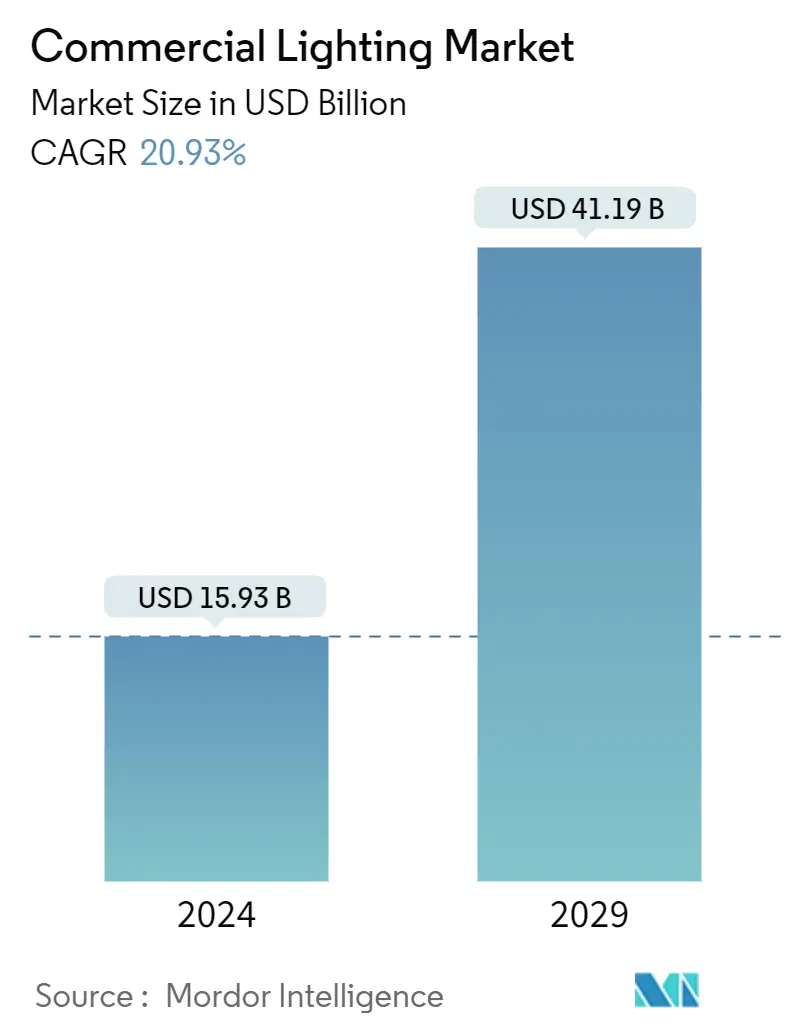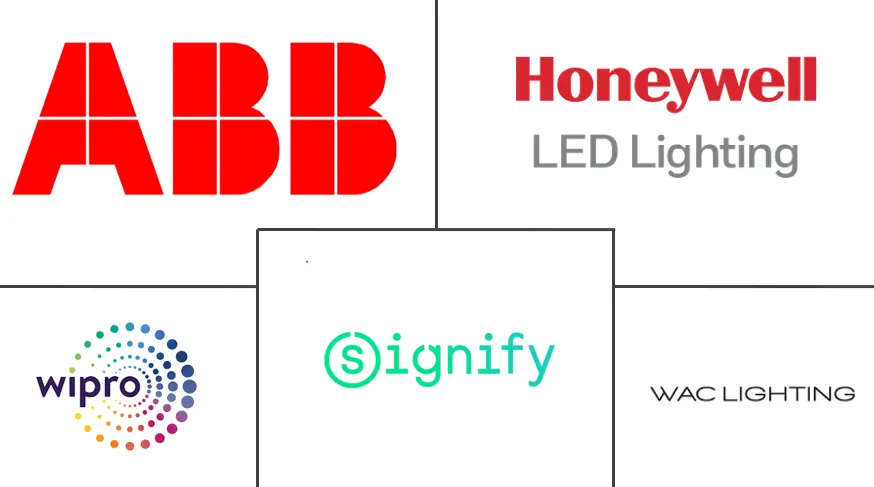Market Size of Commercial Lighting Industry

| Study Period | 2019 - 2029 |
| Market Size (2024) | USD 15.93 Billion |
| Market Size (2029) | USD 41.19 Billion |
| CAGR (2024 - 2029) | 20.93 % |
| Fastest Growing Market | Asia-Pacific |
| Largest Market | Asia-Pacific |
| Market Concentration | High |
Major Players
*Disclaimer: Major Players sorted in no particular order |
Commercial Lighting Market Analysis
The Commercial Lighting Market size is estimated at USD 15.93 billion in 2024, and is expected to reach USD 41.19 billion by 2029, growing at a CAGR of 20.93% during the forecast period (2024-2029).
The growth of the studied market is being significantly fueled by the ongoing and upcoming smart city projects in several nations, the increased focus of governments worldwide on energy consumption, the rising demand for LED lights and luminaires for outdoor applications, and the expanding acceptance of standard protocols for lighting control systems.
Commercial lighting may be customized to fit any facility and its operations based on use. Maintenance requirements, brightness level, and warranties are all significant factors in commercial lighting. Many people can be accommodated in a commercial facility for various activities, including shopping, employment, entertainment, and medical inspection. A lighting design company creates designs that reflect the activity carried out in the facility to ensure that workers are comfortable and that the lux level requirements and the energy efficiency criteria are adequate.
Commercial lighting design must consider light fixtures' use, characteristics, and purpose. T5 and compact fluorescent lights are typical business lighting design fixtures, although LED light fixtures are gaining popularity because of their lower prices.
Well-designed lighting fixtures may illuminate a room's surroundings and create a positive atmosphere. The lighting design at hospitals, hotels, clubs, offices, retail stores, and other commercial facilities must be carefully considered. This is so that business owners may make their location seem welcoming to guests or clients by using a well-designed commercial lighting framework.
Furthermore, it is now simpler for firms to highlight their interiors and design a functional workspace thanks to technology advancements like artificial intelligence and LED lighting. The commercial lighting industry always innovates to lower energy costs, greatly impacting lighting products.
Commercial Lighting Industry Segmentation
Commercial lighting is utilized in places not residential, industrial, or manufacturing-related, such as offices, shops, institutions, hospitals, and government buildings. Commercial lighting often has a more significant initial cost, a longer lifespan, better durability, higher maintenance and repair expenses, and better energy-saving choices than other forms of lighting. The most crucial purpose in business buildings is often finishing a task or activity. To guarantee that employees working in the area are comfortable and that the lux level requirements and energy efficiency standards are appropriate, a lighting design business should produce designs representing the sort of activity conducted in the facility.
The Global Commercial Lighting Market is segmented by Type (Lamps, Luminaries), Lighting Type (LED-based lighting, Traditional), End-user (Commercial Offices, Retail, Hospitality, and Leisure (Restaurants and Sporting facilities), Healthcare), and Geography (North America, United States, Canada, Europe (United Kingdom, Germany, France, Rest of Europe), Asia-Pacific (China, Japan, India and Rest of Asia-Pacific), Latin America, Middle East and Africa). The report offers the market size in value terms in USD for all the abovementioned segments.
| By Type | |
| Lamps | |
| Luminaries |
| By Lighting Type | |
| LED-based lighting | |
| Traditional |
| By End-user | |
| Commercial Offices | |
| Retail | |
| Hospitality and Leisure (Restaurants and Sporting facilities) | |
| Healthcare | |
| Other End-users |
| By Geography | ||||||
| ||||||
| ||||||
| ||||||
| Latin America | ||||||
| Middle East and Africa |
Commercial Lighting Market Size Summary
The commercial lighting market is poised for significant growth, driven by the increasing implementation of smart city projects and a global emphasis on energy efficiency. The demand for LED lights and luminaires, particularly for outdoor applications, is rising as governments worldwide adopt standard protocols for lighting control systems. Commercial lighting is tailored to meet the specific needs of various facilities, ensuring optimal maintenance, brightness, and energy efficiency. The design of lighting systems in commercial spaces such as offices, retail stores, and medical facilities is crucial for creating a welcoming atmosphere and enhancing productivity. Advances in technology, including artificial intelligence and LED lighting, are facilitating the creation of functional workspaces while reducing energy costs.
The market is further bolstered by government initiatives promoting sustainable development and energy conservation, alongside the decreasing costs of LED technology. Intelligent lighting controls, such as sensors and programmable systems, are becoming increasingly popular, offering customized settings and energy savings. The Asia-Pacific region, particularly China, is a significant player in the market, with rapid adoption of LED lighting and substantial government support for energy-efficient products. The competitive landscape is marked by intense rivalry among major vendors, with companies like Wipro and Signify leading innovations in smart lighting solutions. Recent partnerships and product launches, such as those by Acuity Brands and Signify, highlight the industry's focus on integrating advanced technologies to enhance commercial lighting solutions.
Commercial Lighting Market Size - Table of Contents
-
1. MARKET INSIGHTS
-
1.1 Market Overview
-
1.2 Industry Attractiveness - Porter's Five Forces Analysis
-
1.2.1 Bargaining Power of Suppliers
-
1.2.2 Bargaining Power of Buyers
-
1.2.3 Threat of New Entrants
-
1.2.4 Threat of Substitutes
-
1.2.5 Intensity of Competitive Rivalry
-
-
1.3 Industry Ecosystem Analysis
-
1.4 LED Trade Analysis and the Impact of US-China Trade War on the LED Market (Qualitative Trends)
-
1.5 Impact of COVID-19 on the LED Lighting/Emergency Lighting Market
-
-
2. MARKET SEGMENTATION
-
2.1 By Type
-
2.1.1 Lamps
-
2.1.2 Luminaries
-
-
2.2 By Lighting Type
-
2.2.1 LED-based lighting
-
2.2.2 Traditional
-
-
2.3 By End-user
-
2.3.1 Commercial Offices
-
2.3.2 Retail
-
2.3.3 Hospitality and Leisure (Restaurants and Sporting facilities)
-
2.3.4 Healthcare
-
2.3.5 Other End-users
-
-
2.4 By Geography
-
2.4.1 North America
-
2.4.1.1 United States
-
2.4.1.2 Canada
-
-
2.4.2 Europe
-
2.4.2.1 United Kingdom
-
2.4.2.2 Germany
-
2.4.2.3 France
-
2.4.2.4 Rest of Europe
-
-
2.4.3 Asia-Pacific
-
2.4.3.1 China
-
2.4.3.2 Japan
-
2.4.3.3 India
-
2.4.3.4 Rest of the Asia Pacific
-
-
2.4.4 Latin America
-
2.4.5 Middle East and Africa
-
-
Commercial Lighting Market Size FAQs
How big is the Global Commercial Lighting Market?
The Global Commercial Lighting Market size is expected to reach USD 19.26 billion in 2025 and grow at a CAGR of 20.93% to reach USD 49.82 billion by 2030.
What is the current Global Commercial Lighting Market size?
In 2025, the Global Commercial Lighting Market size is expected to reach USD 19.26 billion.

